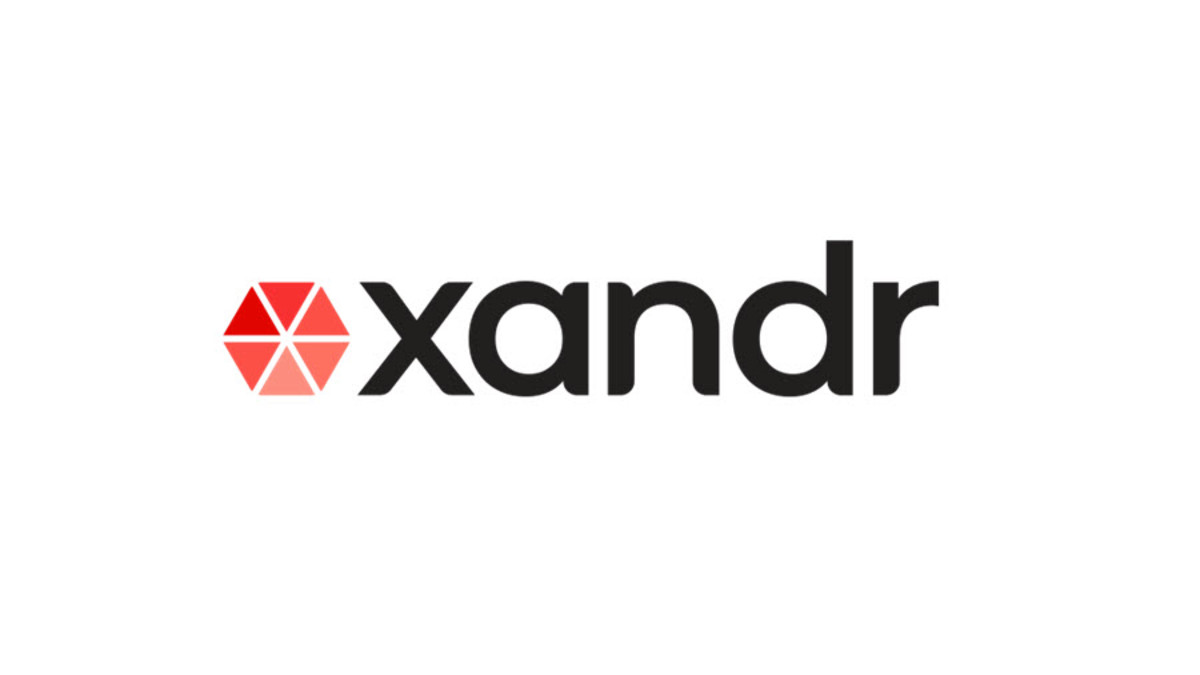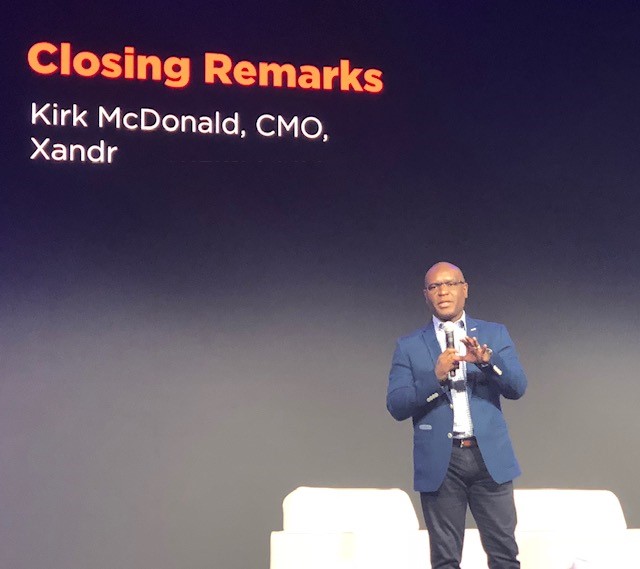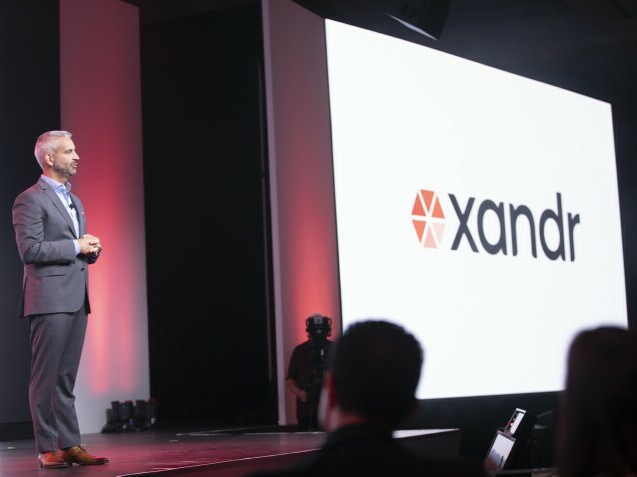Headlines from AT&T Relevance: Industry Leaders Focus on Storytelling, Distribution, Tech and Change

Speaker after speaker at the AT&T Relevance Conference shared insights, ideas and strong points of view about the state of the media and advertising industry. Kirk McDonald hosted the event for Xandr, the newly christened advertising unit of AT&T. Below are comments made by industry leaders from Silicon Valley and Hollywood, as well as Madison Avenue buyers and sellers and successful content providers and distributors. Also speaking were Derek Jeter and Issa Rae, whose comments can be read here. The conference provided an excellent overview of the state of advertising, media and marketing from a wide spectrum of perspectives.
Brian Lesser(pictured below), Xandr -- Xandr is a new kind of advertising company. Advertisers want more choice for how they reach consumers. We are reinventing what it means to advertise to consumers.
Randall Stephenson, Chairman AT&T -- The advertising and media industry is more averse and reluctant to change than any industry I've been in. It doesn't move at all. We need to make a pivot. More intelligence is important for decision-making. Size is a detractor to innovation and speed.
At HBO we need something engaging every day to attract audiences. There will be a 3-5 year capital reorientation to HBO as an everyday experience. Live, time sensitive content is the killer app. News and sports are critically important. We need a connective tissue between Xandr and Turner.
We're making advertising smarter; digital is targeted with good feedback and self-automated. Premium video is not targeted, requires human intervention and sold in Upfronts. It needs to look more like digital.
There is nothing more important to our Constitutional freedoms than the freedom of the press. A free press is critical to our form of government. The full weight of AT&T will be committed to a free press.
If you don't invest in this industry at the top tier, you will not remain a top tier company.

Dave Morris, CBS -- There is a place for new creative formats and we have to make it work. We heard from Randall Stephenson this morning and he commented on the inertia that is present in the media industry. I spent the past 10 years in digital media and I came to the linear TV side of the industry to drive change. What I'm finding is that real change will take time given the complexities of TV distribution. CBS's programming business is solid; over 12 million people watched The Big Bang Theory live on [September 24]. Forty-eight million people watch our programming every day -- 365 days a year -- but the challenge is we don't know who those viewers are, meaning we do not have a one-to-one relationship with our audience and we cannot, yet, serve each household an individual ad. All the TV broadcasters are represented in this room, and we have incredible scale; what we lack is ad relevance at the household level. If we can add advertising relevance to our scale, we will be able to compete with Google, Facebook and Amazon, full stop. So yes, we are very interested to work with new ad formats and as soon as we can integrate them into our ecosystem, we will.
Meg Whitman and Jeffrey Katzenberg -- 2018 is the single most disruptive year in the 100-year history of entertainment.
We're creating bite-sized mobile-only subscription video content of ten minutes. The user and use case are well established consumer behavior. Users spend 4-5 hours daily on their mobile device. Seventy percent of short-form video is viewed on mobile. How do we allow our advertisers to tell a story, to be entertaining? Advertising is content, is entertainment, and we will allow audiences to select advertising.
Are advertisers as brands trying to reimagine messaging? We're not owning the IP; studios will own the IP. Ten studios have signed on. We're charging up Mt. Everest on distribution and content. We'll test and iterate; it's a Silicon Valley model.
Jason Mayden, Super Heroic -- Make sure it's transformational and not just transactional, to be authentic. Content can be a catalyst for motion and movement.
Pam El, NBA -- We are a league of diverse players. Seventy-five percent of NBA players are African American. Fifty percent of the audience is under 35. When anything goes on in the marketplace, and players speak up, it can become a race issue. We're told they should stick to basketball. Thank God players don't stick to basketball and that WNBA players don't just stick to basketball. We want players to have a voice and be represented. We as marketers get to tell real live stories as they are happening. The story lines, like LeBron moving to L.A., are amazing. Our campaign is all about those story lines.
Matt Weiner, Creator of Mad Men and Amazon's The Romanoffs-- I'm doing reverse engineering; stories I want to tell combined with what's not now in the marketplace. We're following the '90s anthology series model. Series TV is amazing; I'm creating stories that resolve themselves each week. We are telling stories that have a commitment to an ending. We are shooting all over the world; each episode in a different location. All contemporary, delivering a special story. Seven films; each will generate a conversation and shared experiences. Shared experiences are something to be sought after.
We are experiencing a low point in self-esteem and we're being hard on ourselves. If we're not being empathetic toward ourselves, how can we be empathetic toward each other? We put up a shell of self-protection that prevents us from being vulnerable.

Randall Rothenberg, IAB -- There's a transcendent shift in the consumer economy as profound as the industrial revolution itself. There is a first-mover advantage driven by ownership of the distribution channel. A shift in growth in the economy is the disruption in multiple categories in which direct-to-consumer products are growing at the expense of legacy brands. More retail stores closed in 2017 than any year in history. The indirect brand economy lasted from 1879-2010. The direct brand economy began in 2010, driven by first-party consumer data and direct-to-consumer relationships.
Jesse Horwitz, Hubble Contacts-- eCommerce is simple to own. The strength is owning the check-out and consumer connections for offers. Five percent of ad inventory is direct response, historically. Today it's 50% of ad inventory. In 1995, 97% of sales were in-store. It's 87% today.
For storytelling, the Facebook newsfeed is valuable. It's the best of both worlds. They are DTC ad units and there's the ability to be in a relevant environment. We need assets and traffic tied to the consumer playground -- to become a destination for advertisers.
Peter Naylor, Hulu-- Creative hasn't kept pace with consumer shifts. They are leaning in to connected TV, creating opportunities with segmented ads and more. If you invest in high impact creative in a new environment, the ROI is significant. The viewer is the disruptive force. Many OTT spaces are commercial free. At Hulu, we give the viewer a choice of ad-free or ad-available. The majority accept ads, but we need to be respectful of the viewer. Restraint is the most important advertising model. We can't overstuff programs with advertising. We need to pay attention to the empowered consumer.
Hulu is a DTC brand. We're 100% IP enabled. We're an easy place for DTC brands to get into TV.
Donna Speciale, Turner-- Creative agencies are not a part of this conversation. Messaging needs to change. We need more cohesiveness between media and creative. Obstacle -- it's not so easy to get to a targeted audience on linear TV. Why can't digital data be applied to linear TV? TV made up of individual parties and open AP is bringing all TV inventory into a simplified platform. We can't be saying "demo" anymore. We need to integrate linear and digital.
We're trying to pull back on commercial loads. We have got to peel it back. In five years we will have holistic campaigns. Premium content will be more valuable.
I can't believe how hard it is to change. There are so many constituencies involved in the change process. Getting all the players aligned is the hardest part.

Pete Stein, Fullscreen-- Advertisers need to covet the consumers' time and treat it with respect
Maverick Carter, Springhill Entertainment-- It's not about promoting. It's not about selling. It's about telling a story that connects with people.
Nike doesn't show sneakers in their advertising. They don't even show feet. They tell stories about athletes in the same way Disney tells stories about superheroes.
Ashkan Karbasfrooshan, WatchMojo-- Sometimes a storyteller needs the courage to think they know what their audience will like, but to succeed you also need the confidence to let your audience take your editorial into areas that you couldn't predict or anticipate. That's how you stay relevant and fresh and keep audiences engaged and excited about your brand and perspective. It just so happens that digital native brands are more comfortable letting go of that control.
Bryan Wiener, comScore -- There is a need in the market to measure across platforms. Trust in data has eroded. All marketers care about is driving purchase decisions and differentiating products. Measuring across all platforms is mission critical for the business. Table stakes is targeting people in advanced audience segments -- reaching people in-market to make purchases. Digital and linear need to become integrated platforms based on data.
Scott Howe, Acxiom -- We need to think holistically across all consumer touch points. Technology works but the industry needs education in telling stories holistically across all touch points.
We need national privacy legislation. A patchwork of different state regulations will be unwieldy. We need an industry rallying cry that puts consumers at the center.
Silos have to come down. Barriers have put huge friction in everything we do and these barriers need to come down.
Nick Brien, Dentsu Aegis -- We're trying to make marketing more emotionally engaging. As more inventory is available we can be more active. There are 30 million live addressable households and 63 million are tech-capable. Storytelling is an omnichannel world. We distinguish between strategies and tactically executing with a ruthless drive to efficiency.
John Muszynski, Publicis Media Exchange-- Ad versioning doesn't make a significant difference in the consumer experience. Clutter has grown. Why is it hard to reduce clutter? It wasn't hard to increase ad inventory and promotional spots. Why is it hard to reduce it and why do advertisers have to pay for it? We have to look at the consumer experience rather than the revenue experience. There is a sincere interest among clients to get involved and reduce waste. Issue is looking at what has worked and, depending on the target, waste may still be valuable if it's a large reach client. For more targeted categories, we look at addressable more closely. Marketing mix modeling clients don't give enough credit to addressable opportunities. They need to find a happy medium -- it's a component of a plan to deliver and set out targets more effectively vs. known mass reach models.
John Swift, Omnicom Media Group-- AT&T has distribution, content and an ad-tech platform. They're the first to have a path to alignment and mobility. They can dimensionalize value. It can't be just about price. We can't lose sight that cheap reach in a contextual environment was the value of TV. It's a journey rather than one or the other.
We don't have a one-dimensional view of value that comes down to price.
Amanda Richman, Wavemaker-- What are the opportunities to grow our clients' businesses by breaking down the silos to address business solutions for clients? We need to qualify outcomes.
Paul Woolmington, Canvas Worldwide-- We are at the beginning of the end of the era in which creative is defined by an uber-creative director. Brand and brand behavior are at the center. We're moving to an era of content, context, contact. Nirvana is a deeper understanding of context. Future is about creatives having a multiplicity of ways to create. The industry is still in the dark ages with an exciting future ahead. Artificial Intelligence is about human interaction. We need to process data and think about how humans will respond. In the old world, creators tended to work in studios. New age publishers are more comfortable creating with data informing the process.
Jesse Redniss, Turner-- We're focused on how we can change the paradigm. It's a five-year process. In five years, we will be completely different. We need to think about the User Interface for audiences and how data can inform it. We are in a transparency state of mind to enhance and drive value for consumers. It's up to us to drive change in the consumer experience and put governance around it.
Tim Barnes, Xandr-- How do we get tools in front of creators? We have an opportunity to inform the creative process through machine learning.

Click the social buttons above or below to share this story with your friends and colleagues.
The opinions and points of view expressed in this content are exclusively the views of the author and/or subject(s) and do not necessarily represent the views of MediaVillage.com/MyersBizNet, Inc. management or associated writers.



